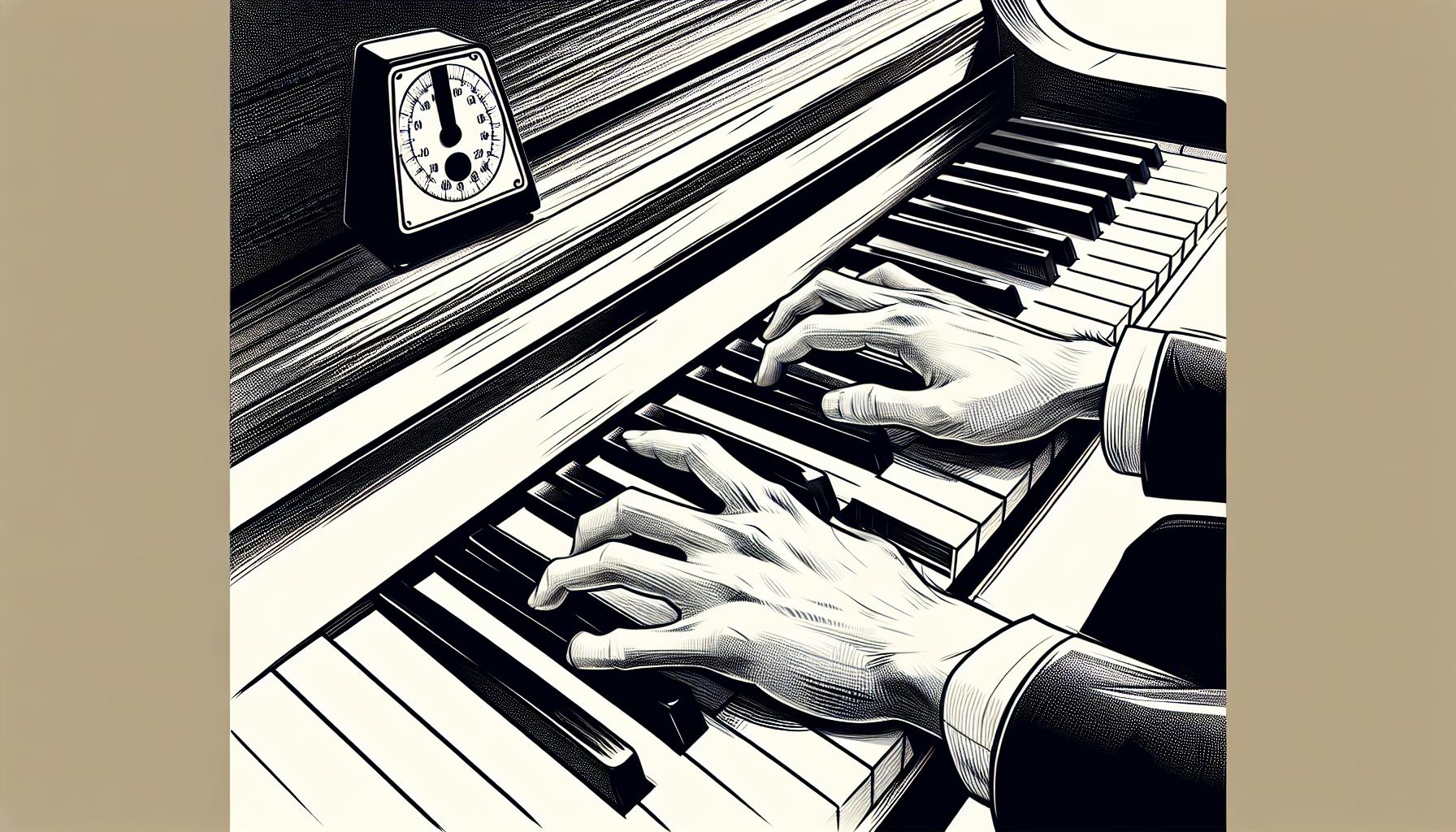Tackling a tricky piano section can feel like climbing a mountain with no peak in sight. But fear not, every pianist, from beginners to the pros, has been there. It's the moment where frustration meets determination, and with the right approach, that difficult section won't know what hit it.
The key lies in not just practicing harder, but smarter. Breaking down the beast, understanding its parts, and using targeted strategies can turn a daunting musical passage into a set of manageable challenges. Let's dive into how you can master those tricky sections, making your practice sessions both productive and enjoyable.
Analyzing the Section
When pianists encounter a difficult section in their music, it's crucial they don't dive in headfirst without a plan. Instead, they should take a moment to analyze the section thoroughly. This means looking beyond the notes on the page and understanding the structure, rhythm, and any patterns that emerge. By doing so, they can gain insights into the composer's intentions and how best to approach the section.
The first step in analyzing is identifying the core challenge. Is it the speed, the complexity of the notes, hand coordination, or perhaps the emotional expression required? Pianists will often find that a tough section is not uniformly difficult. There may be specific bars or patterns that are the real culprits of their frustration. Highlighting these areas helps focus practice where it's most needed.
Breaking down the section into smaller parts is another effective strategy. Instead of tackling the entire segment at once, pianists should divide it into manageable pieces. This could mean separating it by musical phrases, measures, or even note by note for particularly complex parts. Working on these smaller chunks enables pianists to concentrate their effort and build confidence as they master each part.
Rhythm plays a pivotal role in understanding difficult sections. Pianists should experiment with different rhythmic patterns when practicing. For instance, they might elongate certain notes or add pauses between others, not for performance purposes but as a practice tool to better grasp the timing and dynamics of the passage.
Analyzing fingerings is also essential. Sometimes, the difficulty arises not from the music itself but from inefficient finger placement. Pianists should experiment with various fingering options to find the most comfortable and effective ones. Consulting with experienced teachers or referencing professional recordings can provide insights into possible fingering solutions.
In addition to technical aspects, emotional analysis is vital. Understanding the mood or message the composer intends to convey can influence how a pianist approaches the dynamics and phrasing of a section. It's not just about the notes but how they're played that makes a performance truly captivating.
Setting Specific Goals

When tackling challenging piano sections, setting specific goals is not just productive, it's essential. Instead of approaching practice with a vague aim like "get better," pianists should define clear, achievable objectives. This method creates a roadmap for success, breaking down the nebulous task of overall improvement into tangible milestones.
One effective strategy is to focus on one aspect of playing at a time. For example, a pianist could set a goal to master the rhythm of a tricky passage before attempting to play it at the composed tempo. This approach ensures that each element of the music—rhythm, melody, and dynamics—receives due attention, resulting in a more polished performance.
Short-Term Goals are crucial for maintaining momentum. These could range from mastering a specific measure to perfecting the transition between two difficult sections within a week. Short-term goals offer immediate challenges and quick rewards, boosting confidence as each is achieved.
Long-Term Goals require a broader focus and a longer time frame. An example could be the complete memorization of a complex piece or achieving a performance-ready state in several months. Long-term goals help pianists stay committed and motivated over time, providing a vision of what they're striving to achieve.
Utilizing a mix of both short-term and long-term goals allows pianists to enjoy progress and maintain focus. Recording these goals in a practice journal or digital app also provides a way to track progress, adjust strategies as needed, and celebrate accomplishments.
Goal Flexibility plays a key role in the practice process. Sometimes, despite best efforts, certain goals might not be met within the original timeframe. When this happens, it's important for musicians to reassess and adjust their goals without viewing it as a failure. Adjusting goals based on progress and feedback is a sign of a thoughtful and adaptable learning approach.
In addition to setting personal goals, seeking feedback from teachers and peers can provide valuable insights. External perspectives can help identify areas that need more focus, suggest alternative strategies for difficult sections, and reinforce progress.
By incorporating specific, achievable goals into their practice routine, pianists create a structured approach to overcoming difficult sections. This not only aids in mastering challenging passages but also in cultivating a sense of purpose and accomplishment throughout the learning process. With dedicated practice, a clear set of goals, and the willingness to adapt, pianists can elevate their skills and achieve a deeper musical understanding.
Slow and Steady Wins the Race

When approaching a difficult piano section, one might be tempted to dive right in at full tempo, hoping to master it through sheer repetition. However, practicing slowly is a more effective method. This approach allows the musician to focus on precision, ensuring that every finger placement and pedal use is deliberate and correct. By breaking down the music into manageable chunks and playing them slowly, learners can develop a deep understanding of the musical piece, both technically and emotionally.
It's essential to remember that playing slowly is not just about reducing the tempo. It's about creating the opportunity to pay attention to detail. When pianists slow down, they're able to notice subtle aspects of their performance that might be overlooked at a higher speed. This includes dynamics, articulation, and phrasing, which are critical to bringing music to life. Integrating these elements at a slow tempo makes it much easier to retain them as the speed increases.
Another key benefit of practicing slowly is reducing the risk of developing bad habits. Rushing through a difficult piano section without fully understanding or mastering it can lead to mistakes being repeated and ingrained. These habits can be hard to break and may hinder progress in the long run. Slow practice ensures that learners are consciously making every note count, which promotes the development of good playing habits that stand the test of time and speed.
Using a Metronome
Incorporating a metronome into slow practice can further enhance the effectiveness of this approach. A metronome provides a consistent beat that can help pianists maintain a steady tempo, even when playing slowly. This can be particularly beneficial for sections of music that are rhythmically complex or require precise timing. Over time, using a metronome helps to develop an internal sense of timing and rhythm that is crucial for any musician.
Incremental Increases in Speed
Once a section has been mastered at a slow speed, the next step is to gradually increase the tempo. This should be done in small, manageable increments, allowing the pianist to maintain accuracy and expression at slightly higher speeds. It's important not to rush this process—the goal is to seamlessly integrate the technical and emotional aspects of the music at every stage of speed increase.
| Starting Tempo (BPM) | Increment Increase | Goal Tempo (BPM) |
|---|---|---|
| 60 | 5-10 | Performance Speed |
Utilizing Different Practice Techniques

Practicing a difficult piano section requires more than just repetition. Players should incorporate a variety of techniques to tackle the challenges effectively.
Breaking It Down
One of the most effective strategies is to break down the music into smaller, manageable segments. Instead of attempting to conquer the entire section at once, they can focus on one measure or phrase at a time. This method allows pianists to concentrate on mastering each note, rhythm, and hand movement without the overwhelm of the complete piece.
Hands Separately
Initially, playing hands separately can greatly improve one's understanding and execution of a piece. By isolating each hand, musicians can identify and address specific technical difficulties, ensuring that both hands are equally prepared. Once comfortable, they can slowly begin combining their hands, first at a slower pace before gradually increasing speed.
Use of a Metronome
The metronome remains an indispensable tool in practicing difficult sections. Starting with a tempo significantly below the performance speed, allows for meticulous attention to detail. Through persistent practice, the tempo can be gradually increased, ensuring that precision is not sacrificed for speed.
Gradual Tempo Increase
| Starting Tempo (%) | Intermediate Tempo (+5%) | Near-Performance Tempo (+10%) |
|---|---|---|
| 60% | 65% | 70% |
This table demonstrates a recommended progression for increasing tempo.
Focus on Dynamics and Articulation
Pianists shouldn't overlook the musicality of the section while focusing on the technical aspects. Dynamics and articulation are vital in bringing music to life, so it's crucial to incorporate these elements early in the learning process. Manipulating volume and emphasizing certain notes can drastically change a piece's expressiveness and emotional impact.
Incorporating Rhythms
Altering the rhythm of tricky passages can help overcome technical barriers. By practicing with a variety of rhythms — long notes followed by short notes and vice versa — pianists can better prepare their fingers for the actual rhythms of the piece. This also makes practice sessions more engaging and less monotonous.
Recording and Listening
Recording practice sessions and listening back is an invaluable technique that's often overlooked. It allows musicians to critique their performance objectively, identifying areas for improvement that they might not notice while playing. This self-assessment can guide further practice and refine technique.
Putting it All Together

After focusing on individual practice techniques for mastering difficult piano sections, combining these methods effectively becomes crucial. They've tackled the sections bit by bit, practiced hands separately, and used the metronome diligently. Now, it's time to put all these pieces into a cohesive whole. This synthesis of techniques not only enhances their playing but also deepens their musical understanding.
First, they should begin by revisiting the piece as a whole. Playing through the entire piece, or at least larger sections, helps them understand how the challenging parts fit into the broader context. It's not just about perfecting difficult sections in isolation; it's about how these sections contribute to the overall performance.
Next, incorporating dynamics and articulation from the start ensures that they don't become an afterthought. As they integrate the challenging sections with the rest of the piece, paying close attention to the composer's markings brings the music to life. This approach makes the transition between practice and performance smoother and more natural.
Another key aspect is adapting the tempo. Initially, practicing slowly helps with accuracy and precision. However, as they begin to feel more comfortable, gradually increasing the tempo to reach performance speed is vital. This doesn't mean rushing through the piece. It's about finding the right balance between technical proficiency and expressiveness.
Incorporating different rhythms and patterns into their practice at this stage can also be beneficial. By playing around with the rhythm, they challenge their fingers and brain to adapt, making the standard rhythm of the piece easier to perform. This technique not only solidifies their grasp of the difficult sections but also enhances their overall rhythmic accuracy.
Finally, the role of self-assessment cannot be overstated. Recording their practice sessions and listening back provides invaluable insights. They might notice things they miss while playing, such as subtle timing issues or places where the dynamics could be more pronounced. This self-reflection fosters a more critical and mindful approach to their practice.
As they integrate these strategies, they'll find that their confidence and competence in handling challenging sections improve markedly. It's a process that requires patience, consistency, and a willingness to experiment with different approaches. The goal is not just to play the notes correctly but to convey the music's emotions and stories. By putting it all together, they're not just practicing piano; they're becoming musicians in the fullest sense.
Conclusion
Tackling difficult piano sections isn't just about putting in the hours. It's about smart, focused practice that leverages a blend of techniques tailored to each musician's needs. By integrating these strategies, pianists not only overcome technical challenges but also deepen their musical understanding. This approach ensures that every note played contributes to their growth as musicians, enabling them to express themselves more fully through their music. So grab your sheet music, sit at your piano, and remember: every great musician was once a beginner, facing the same challenges you are now. With patience, perseverance, and the right approach, there's no piece you can't master.
Harlan Kilstein began playing piano during covid with no piano background at all. He taught himself how to play learning what to do and what not to do.
Today he's an advanced intermediate player and can help you grow in your skills because he learned all this on his own.








